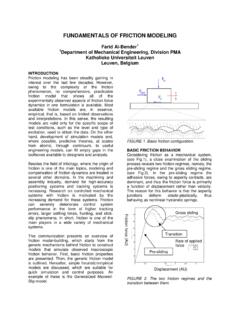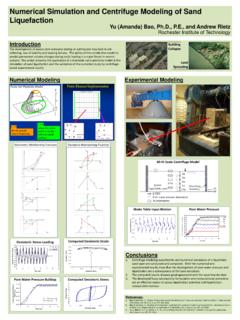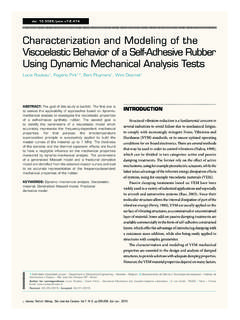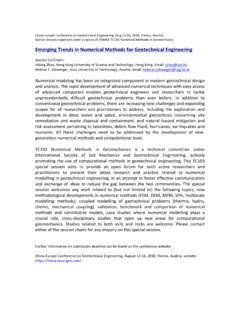Transcription of CONSTITUTIVE MODELING OF ENGINEERING …
1 CONSTITUTIVE MODELING OF ENGINEERINGMATERIALS - theory AND COMPUTATIONThe PrimerbyKenneth RunessonLecture Notes, Dept. of Applied Mechanics,Chalmers University of Technology, G oteborgPrefaceThere seems to be an ever increasing demand in ENGINEERING practice for more realisticmodels as applied to metals as well as composites, ceramics,polymers and geologicalmaterials (such as soil and rock). Consequently, a vast amount of literature is availableon the subject of nonlinear CONSTITUTIVE MODELING , with strong emphasis on plastic-ity and damage. Such MODELING efforts are parallelled by the development of numericalalgorithms for use in Finite Element environment.
2 For example, implicit (rather than ex-plicit) integration techniques for plasticity problems are now predominant in am indebted to a great number of people who have contributedto the present volume:Mr. M. Enelund, Mr. L. Jacobsson, Mr. M. Johansson, Mr. L. M ahler and Mr. T. Svedberg,who are all graduate students at Chalmers Solid Mechanics, have read (parts of) themanuscript and struggled with the numerical examples. Mr. T. Ernby prepared some ofthe difficult figures. Ms. C. Johnsson, who is a graduate student in ancient Greek historyat G oteborg University, quickly became an expert in handling equations in LATEX. Thecontribution of each one is gratefully oteborg in March Runesson2nd revised edition:I am grateful to Mr.
3 Lars Jacobson and Mr. Magnus Johansson (in particular) for theirhelp in revising parts of the oteborg in March Runesson3rd revised edition:Ms. EvaMari Runesson, who is a student in English at the University of Gothenburg (andalso happens to be my daughter) did an excellent job in mastering LATEXfor this oteborg in March Runesson4th revised edition:Mr. Lars Jacobsson and Ms. EvaMari Runesson were of great help in typing the oteborg in January Runesson5th revised edition:Some small changes were made to improve the oteborg in January Runesson6th revised edition:Ms. Annicka Karlsson was of great help in revising the manuscript, mainly concerning oteborg in January 2002 Kenneth Runesson7th revised edition:The help by Mr.
4 Mikkel Grymer in revising the manuscript is greatly oteborg in March 2005 Kenneth RunessonVol 0 March 7, 2006viVol 0 March 7, 2006 Contents1 CHARACTERISTICS OF ENGINEERING MATERIALS AND CON-STITUTIVE General remarks on CONSTITUTIVE MODELING .. Concept of a CONSTITUTIVE model .. The role of CONSTITUTIVE MODELING .. General constraints on CONSTITUTIVE models .. Approaches to CONSTITUTIVE MODELING .. MODELING of material failure Fracture .. Continuum damage mechanics .. Fracture mechanics .. Common experimental test conditions .. Typical behavior of metals and alloys .. Plastic yielding Hardening and ductile fracture.
5 Constant loading Creep and relaxation .. Time-dependent loading Rate effect and damping .. Cyclic loading and High-Cycle-Fatigue (HCF) .. Cyclic loading and Low-Cycle-Fatigue (LCF) .. Creep-fatigue and Relaxation-fatigue .. Typical behavior of ceramics and cementitious composites .. Monotonic loading Semi-brittle fracture .. 21 Vol 0 March 7, Cyclic loading and fatigue .. Creep and relaxation .. Typical behavior of granular materials .. Monotonic loading Basic features .. Constant loading Consolidation .. Constant loading Creep and relaxation .. 232 THERMODYNAMICS A BRIEF Free energy and CONSTITUTIVE relations.
6 General .. Stress-strain response relation .. material classes .. 273 Introduction .. Prototype model: The Maxwell rheological model .. Thermodynamic basis CONSTITUTIVE relation .. Prescribed constant stress (pure creep) .. Prescribed constant strain (pure relaxation) .. Linear viscoelasticity CONSTITUTIVE MODELING .. General characteristics .. Laplace-Carson transform .. Linear Standard Model (Generalized Maxwell Model) .. Backward Euler method for linear standard model .. Linear viscoelasticity Structural analysis .. Structural behavior .. Solution strategies .. Analysis of truss Elastic analogy.
7 44 Vol 0 March 7, Analysis of truss numerical integration .. Analysis of beam cross-section Elastic analogy .. Analysis of double-symmetric beam cross-section Numerical in-tegration .. Nonlinear viscoelasticity CONSTITUTIVE MODELING .. General characteristics .. Norton creep law .. Backward Euler method for the Norton creep law .. Nonlinear viscoelasticity structural analysis .. Structural behavior .. Analysis of truss .. Analysis of beam cross-section Stationary creep .. Analysis of double-symmetric beam cross-section Numerical in-tegration .. Analysis of single-symmetric beam cross-section Numerical inte-gration.
8 Viscous damping and dynamic behavior .. Preliminaries .. Forced vibration of discrete system .. Energy dissipation .. Evaluation of damping for the linear standard model .. Appendix : Laplace - Carson transform .. 754 Introduction .. Prototype rheological model for perfectly plastic behavior .. Thermodynamic basis Yield criterion .. Plastic flow rule and elastic-plastic tangent relation .. 80 Vol 0 March 7, Dissipation of energy .. Prototype model for hardening plastic behavior .. Thermodynamic basis Yield criterion .. Plastic flow rule and elastic-plastic tangent relation .. Dissipation of energy.
9 Model for cyclic loading Mixed isotropic and kinematichardening .. Thermodynamic basis Yield criterion .. Associative flow and hardening rules Linear hardening .. Characteristic response for linear hardening .. Associative flow and nonassociative hardening rules Nonlinearhardening .. Characteristic response for nonlinear hardening .. Backward Euler method for integration Linear hardening .. Structural analysis .. Structural behavior Limit load analysis .. Analysis of truss Numerical integration .. Analysis of double-symmetric beam cross-section .. Analysis of single-symmetric beam cross-section Numerical inte-gration.
10 1065 Introduction .. Prototype rheological model for perfectly viscoplastic behavior .. Thermodynamic basis Quasistatic yield criterion .. Viscoplastic flow rule Perzyna s formulation .. Bingham model Perzyna s formulation .. Norton model (creep law) Perfect viscoplasticity .. 114 Vol 0 March 7, Limit behavior Viscoplastic regularization of rate-independentplasticity .. Prototype rheological model for hardening viscoplasticity .. Thermodynamic basis Quasistatic yield criterion .. Viscoplastic flow and hardening rules Perzyna s formulation .. Bingham model Perzyna s formulation .. Viscoplastic flow and hardening rules Duvaut-Lions formulation Comparison of Perzyna s and Duvaut-Lions formulations.






